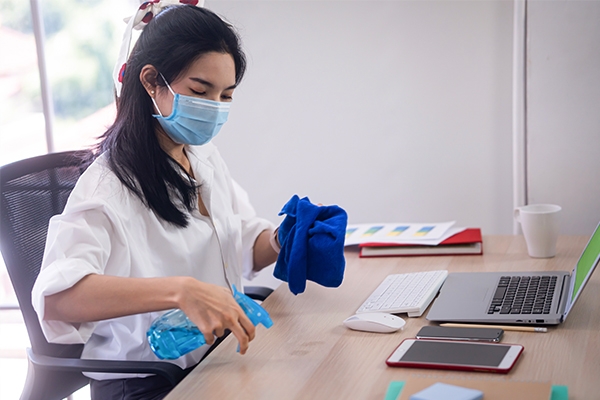Office Workers’s Health Problems

Even though they just sit behind a desk, office workers are not immune to injuries or illnesses. Here are some of the health problems that affect them.
Musculoskeletal problems
This term refers to injuries to muscles, nerves, tendons, joints, cartilage, and spinal discs. They do not include injuries caused by slips, trips, falls, or other similar incidents.
Office workers suffer from musculoskeletal problems, such as muscle stiffness, joint pain and stiffness, and swelling in the affected area, which can impair movement.
Common musculoskeletal problems include:
- sprains
- muscle tension
- back pain
- neck pain
- CTS (carpal tunnel syndrome)
1. CTS (Carpal Tunnel Syndrome)

CTS is a frequent office ailment today. It was initially discovered at the end of World War II. CTS was disregarded until the 1970s because it was considered an excuse for office workers to skip work.
CTS is caused by repetitive movements that put a strain on the median nerve in the carpal tunnel, such as typing on a computer. This pressure can cause inflammation and irritation of the nerve, which then leads to symptoms of CTS, such as:
- pain in the hands and fingers, especially at night
- numbness, tingling, and weakness in the hands and fingers
- difficulty grasping objects
Prevention
Stretching and resting for a few minutes can help relieve wrist stress. When typing on a computer or using a mouse, don't use your wrist for support.
CTS is treated based on its severity. In mild cases, CTS can be treated by:
- compress the inflamed area using cold water.
- do stretches and hand exercises.
- change your work habits
2. Lower back pain

Sitting still for hours, poor sitting posture and excessive activity are the main triggers for muscle tension and lower back pain in office workers.
Prevention
1. Pay attention to your sitting posture
- Sit up straight and lean your back against the chair.
- Position your head and neck in line with your shoulders.
- Make sure your feet are flat on the floor or use a footrest.
- Avoid crossing your legs
- Adjust the height of your chair and table so that your elbows are the same level as your keyboard and monitor.
- Use an ergonomic chair with good back support.
2. Rest and physical activity
- Get up and move around every 20–30 minutes.
- Do simple stretches to relieve muscle tightness.
- Get regular exercise, such as swimming, walking, or yoga.
- Maintain the ideal body weight.
- Avoid lifting heavy objects the wrong way.
3. Create an ergonomic working environment
- Use an ergonomic keyboard and mouse.
- Position the screen at eye level.
- Use sufficient lighting.
- Occasionally, change your sitting position.
Consult a doctor or physiotherapist if lower back pain does not improve.
Eyes strain

Staring at a computer, tablet, or gadget screen for a long time can cause blurry and sensitive eyes, excessively watery or dry eyes, headaches or neck pain, tight shoulders, and problems focusing.
The intensity of eyestrain can vary depending on the screen used, duration of use, lighting conditions, and eye condition.
Prevention
1. Set the screen appropriately
- Adjust the screen brightness to match the room lighting.
- Use an anti-glare filter on the screen.
- Set the viewing distance between the screen and your eyes to around 50–60 cm.
- Position the screen slightly lower than eye level.
2. Rest your eyes regularly
- Use the 20-20-20 rule: Every 20 minutes, look away from the screen for 20 seconds and focus on an object 20 feet (6 meters) away.
- Close your eyes for a few minutes every hour.
3. Create healthy habits
- Drink plenty of water to keep your eyes hydrated.
- Consume foods rich in vitamins A and C.
- Get enough sleep.
- Have regular eye examinations
Obesity

Obesity is not a new issue, but it is a problem that is getting worse in the modern era. Lack of exercise, increased stress, junk food intake, a sedentary lifestyle, and a variety of other factors contribute to the increasing prevalence of obesity among workers worldwide.
If you enjoy eating snacks during working hours, be careful. Various snacks are often high in calories, high in sugar, and fat, but low in fiber. Therefore, it is important to plan what you will consume so as not to consume too much.
Obesity is the main factor causing increased LDL cholesterol levels in the blood, blood clots, and various other medical conditions.
Prevention
1. Pay attention to your food intake
- Choose foods that are healthy and nutritionally balanced.
- Avoid junk food, foods high in sugar and fat, and processed foods.
- Pay attention to meal portions and avoid overeating.
- Eat healthy snacks, such as fruit, yogurt, or nuts.
2. Increase physical activity
- Exercise regularly—at least 30 minutes per day.
- Use the stairs instead of the elevator.
- Park a little further away and walk.
- Do some stretching or light movement between work hours.
3. Manage your stress
- Practice relaxation techniques, such as yoga, meditation, or listening to music.
- Take time to do activities you enjoy.
- Get enough sleep.
Mental health

Mental health is as important as physical health. In today's competitive environment, as workplace stress increases, employees are becoming more susceptible to mental health problems.
Work-related stress not only impacts employee health and well-being but also company productivity. There are many causes. For example, feeling stressed if the demands of the job (such as working hours or responsibilities) are greater than what can be done comfortably. Other sources of work-related stress include conflicts with coworkers or supervisors and threats to job security, such as the potential for layoffs.
Workplace stress can increase the risk of cardiovascular disease (obesity, hypertension, and high cholesterol) and adverse cardiovascular events, such as stroke and heart attack.
Prevention
Make sure that your work is well organized. List the priority tasks. For example, completing “difficult” tasks in the morning when your mind is still fresh.
Virus or germ infection

In your opinion, which of these two places has the most germs? Toilet seat or work desk? Yes, you might have already assumed that the toilet seat is a nest for germs. But wait a minute! You are mistaken.
It turns out that the work desk has the most germs. Every time we touch a keyboard, mouse, table, or device, we also touch germs. There are more than 10 million germs on the table!
Germs can cause various diseases, such as flu, fever, and digestive infections. Germs can also trigger allergies and asthma.
Prevention
- Clean your work desk regularly. Use disinfectant to clean your desk surface, keyboard, and mouse.
- Wash your hands: Wash your hands with soap and running water or use hand sanitizer after going to the toilet, before eating, and after touching dirty objects.
- Avoid eating at your desk. Eat in a clean place away from your computer.
- Maintain personal hygiene: shower regularly and pay attention to clean clothing.
If you are experiencing any of the signs and symptoms listed above, it is recommended that you seek medical help immediately. You can consult with the nearest GWS Medika doctor to obtain an appropriate medical diagnosis and treatment.



